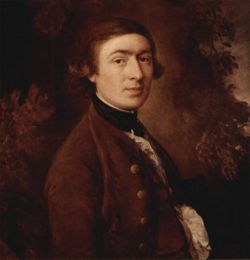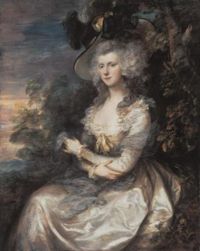Thomas Gainsborough
2008/9 Schools Wikipedia Selection. Related subjects: Artists
- This article is about the artist Thomas Gainsborough. Gainsborough is also the name of a small market town in Lincolnshire in England.
| Thomas Gainsborough | |
 Self-portrait, painted 1759 |
|
| Birth name | Thomas Gainsborough |
| Born | 14 May 1727 (baptised) Sudbury, Suffolk, England |
| Died | 2 August 1788 |
| Nationality | British |
| Field | Painter |
Thomas Gainsborough ( 14 May 1727 (baptised) – 2 August 1788) was one of the most famous portrait and landscape painters of 18th century Britain.
Gainsborough was born in 1727 in Sudbury, Suffolk, England. His father was a schoolteacher involved with the wool trade. At the age of fourteen he impressed his father with his pencilling skills so that he let him go to London to study art in 1740. In London he first trained under engraver Hubert Gravelot but eventually became associated with William Hogarth and his school. One of his mentors was Francis Hayman. In those years he contributed to the decoration of what is now the Thomas Coram Foundation for Children and the supper boxes at Vauxhall Gardens.
In the 1740s, Gainsborough married Margaret Burr, an illegitimate daughter of the Duke of Beaufort, who settled a £200 annuity on the couple. The artist's work, then mainly composed of landscape paintings, was not selling very well. He returned to Sudbury in 1748–1749 and concentrated on the painting of portraits.

In 1752, he and his family, now including two daughters, moved to Ipswich. Commissions for personal portraits increased, but his clientele included mainly local merchants and squires. He had to borrow against his wife's annuity.
In 1759, Gainsborough and his family moved to Bath. There, he studied portraits by van Dyck and was eventually able to attract a better-paying high society clientele. In 1761, he began to send work to the Society of Arts exhibition in London (now the Royal Society of Arts, of which he was one of the earliest members); and from 1769 on, he submitted works to the Royal Academy's annual exhibitions. He selected portraits of well-known or notorious clients in order to attract attention. These exhibitions helped him acquire a national reputation, and he was invited to become one of the founding members of the Royal Academy in 1769. His relationship with the academy, however, was not an easy one and he stopped exhibiting his paintings there in 1773.
In 1774, Gainsborough and his family moved to London to live in Schomberg House, Pall Mall. In 1777, he again began to exhibit his paintings at the Royal Academy, including portraits of contemporary celebrities, such as the Duke and Duchess of Cumberland. Exhibitions of his work continued for the next six years.
In 1780, he painted the portraits of King George III and his queen and afterwards received many royal commissions. This gave him some influence with the Academy and allowed him to dictate the manner in which he wished his work to be exhibited. However, in 1783, he removed his paintings from the forthcoming exhibition and transferred them to Schomberg House.
In 1784, royal painter Allan Ramsay died and the King was obliged to give the job to Gainsborough's rival and Academy president, Joshua Reynolds. However Gainsborough remained the Royal Family's favourite painter.
In his later years, Gainsborough often painted relatively simple, ordinary landscapes. With Richard Wilson, he was one of the originators of the eighteenth-century British landscape school; though simultaneously, in conjucntion with Joshua Reynolds, he was the dominant British portraitist of the second half of the 18th century.
Gainsborough painted more from his observations of nature (and human nature) than from any application of formal academic rules. The poetic sensibility of his paintings caused Constable to say, "On looking at them, we find tears in our eyes and know not what brings them." He himself said, "I'm sick of portraits, and wish very much to take my viol-da-gam and walk off to some sweet village, where I can paint landskips (sic) and enjoy the fag end of life in quietness and ease."
His most famous works, such as Portrait of Mrs. Graham; Mary and Margaret: The Painter's Daughters; William Hallett and His Wife Elizabeth, nee Stephen, known as The Morning Walk; and Cottage Girl with Dog and Pitcher, display the unique individuality of his subjects.
Gainsborough's only known assistant was his nephew, Gainsborough Dupont. He died of cancer on 2 August 1788 in his 62nd year.
Trivia
- In Ghostbusters II (1989), Dr. Janosz Poha exclaims to Peter Venkman, with heavy accent approximated, "Theees eeesn't Gainsborough's Blue Boy, ees Preeence Veego, Ruler of Carpathia and Moldavia!"
- His sitters tend to look rather similar, and supposedly when one client complained that the portrait did not resemble his wife at all, he told him not to worry, in a few years time no-one would know the difference.
- If he was painting a portrait of a woman (alone, not as a member of a couple) that he did not personally find attractive, he would paint a dog in the portrait.
In Fiction
- Kitty (Paramount 1945) is a notable fictionl film about Gainsborough see http://www.imdb.com/title/tt0037849
- Gainsborough has an important posthumous role in the alternate history novel The Two Georges by Harry Turtledove. In the alternate history depicted in the book, the 18th Century American colonists reached a compromise with the British government which averted the American War of Independence and let North America remain part of the British Empire in gthe 20th Century. In this world, Gainsborough painted a picture of King George III and George Washington signing on the historic compromise. In later generations this picutre ("The Two Georges of the title) becomes a famous iconic symbol of the harmonious good relations between Btitiain and the North American Union, with copies of it to seen everywhere and its facsimile appearing on currency notes. The whole plot of the novel turns on its theft by terrorists and the efforts to recover it.


